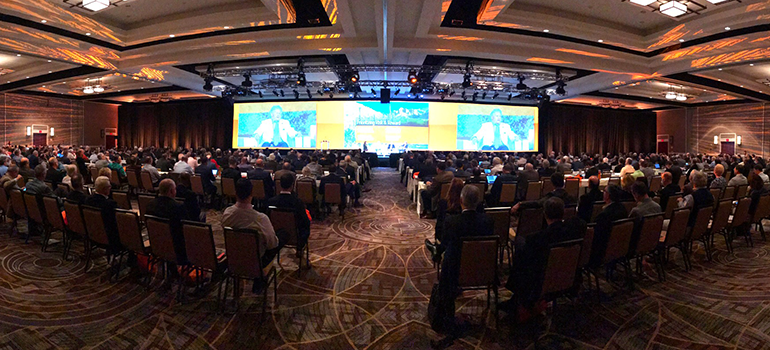
Cautious Optimism for Bank M&A
 There is a general sense of optimism about the state of deal-making in the banking industry at Bank Director’s Acquire or Be Acquired conference in Phoenix, Arizona. Bankers and industry observers pointed repeatedly throughout the first day to the fact that bank stock valuations have soared in the 14 months since the 2016 presidential election, opening up new possibilities for interested buyers and sellers.
There is a general sense of optimism about the state of deal-making in the banking industry at Bank Director’s Acquire or Be Acquired conference in Phoenix, Arizona. Bankers and industry observers pointed repeatedly throughout the first day to the fact that bank stock valuations have soared in the 14 months since the 2016 presidential election, opening up new possibilities for interested buyers and sellers.
Bank stocks faced an uncertain if not bleak future two years ago, a point that Thomas Michaud, president and CEO of Keefe, Bruyette & Woods, used to set the scene for the state of banking in 2018. Oil prices had dropped to below $30 a barrel, economic growth in China seemed to be tempering and the United Kingdom was lurching towards a nationwide referendum on quitting the European Union. This trifecta of bad news led bank stocks to drop, producing a dour outlook for prospective sellers.
Yet, you only had to flash forward to the end of 2016 to find a dramatically altered landscape. Stocks soared following the presidential election. And no industry benefited more than banks, where share prices rose by nearly a third over the next four months. Since the beginning of 2016, large-cap bank stocks have climbed 55 percent while regional bank stocks have gained 44 percent—both having bettered the S&P 500’s 36 percent advance over the same stretch.
This has resulted in meaningfully higher valuations, a core driver of deal activity. Prior to the presidential election, banks were valued below their 15-year median of 15.2 times forward earnings per share estimates. After peaking at 18.8 times forward earnings in the immediate wake of the election, they have settled at 15.4. But even though bank valuations are up, which makes deals more attractive to buyers and sellers with higher multiples, they are nowhere near euphoric levels, given the mere 20 basis point premium over the long-run average.
Virtually everyone you talk to at this year’s gathering of more than 1,000 bankers from across the country believes there is still room for these valuations to climb even higher. This was a point made in a session on the drivers of a bank’s value by Curtis Carpenter, principal and head of investment banking at Sheshunoff & Co. Investment Banking. In just the last five weeks of 2017, six deals priced for more than two times tangible book value were announced, creating strong momentum for 2018.
Underlying all of this is an improved outlook for bank profitability, the primary determinate of valuation. In the immediate wake of the financial crisis, it was common to hear people say that banks would be lucky to return 1 percent on their assets. Now, a combination of factors is leading people like Michaud to forecast that the average bank will generate a 1.2 percent return on assets.
Multiple factors are playing into this, beginning with the pristine state of the industry’s asset quality. You have to go back to the 1970s to find the last time the current credit outlook for banks was this good, says Michaud. This has some industry observers watching closely. One of them is Tim Johnson, who leads KPMG LLP’s deal advisory financial services sector. Johnson commented in a panel discussion on deal-making that he believes the consumer credit cycle could take a turn for the worse this year. But there are others, like Tom Brown, founder and chief executive officer of the hedge fund Second Curve Capital, who doesn’t see any reason to be worried about consumer credit trends in light of the low unemployment rate and high consumer confidence.
The expected changing of the guard atop the regulatory agencies is a second factor fueling optimism that profitability will improve this year. Former banker Joseph Otting is the new comptroller of the currency, while Jerome Powell has been confirmed as the new chair of the Federal Reserve Board. Jelena McWilliams awaits confirmation by the U.S. Senate as the new chairman of the Federal Deposit Insurance Corp., and President Donald Trump is expected to nominate a new director to lead the Consumer Financial Protection Bureau. While there are few signs of tangible benefits in terms of a lower compliance burden from the new administration, this should eventually change once new leaders are in place at the top of all of the agencies.
Last but not least, the biggest boost to profitability in the industry will come from the recently enacted corporate tax cuts, which lower the corporate income tax rate from 35 percent down to 21 percent. The drop is so significant that it caused KBW to raise its earnings estimates for banks by 14 percent in 2018 and 12 percent in 2019. And when you factor in the likelihood that many banks will use the savings to buy back stock, KBW projects that earnings per share in the industry will climb this year by 25.6 percent over 2017.
The atmosphere on the first day of the conference was thus upbeat, with presenters and attendees projecting a sense of cautious optimism over the improved outlook for the industry. At the same time, there is recognition that the longer-term macro consolidation cycle that shifted into high gear following the elimination of laws against interstate banking in the mid-1990s could soon reach critical mass. If that were to happen, banks that don’t capitalize on today’s improved outlook by seeking a partner could be left standing alone at the merger alter.



